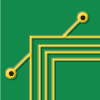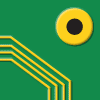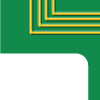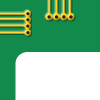This keyboard is in good condition. Completely tested including reset and programming functions. PS/2 connector. See Pictures. Fully tested. Information from the web follows.
The AnyKey keyboard is easily distinguished from other generic keyboards by an extra double column of F keys on the left side, a unique eight directional arrow key pad as opposed to the traditional inverted T, and a quartet of extra keys directly above the numeric pad that control the programmable aspects of the keyboard. They are labeled “Program Macro”, “Suspend Macro”, “Repeat Rate”, and “Remap”, reading left to right. All versions of the AnyKey are white or very light gray with some keys (notably the programming keys, extra function keys, and arrows) in a darker gray.
Features and Construction
The AnyKey is a 124 key PC keyboard, including the usual compliment of 101 keys in addition to others. It includes 12 extra F keys, four programming keys, and four additional arrow keys for diagonal input, as well as one blank key in the center of the eight way arrow key area that normally acts as a second Space Bar but can be programmed. Also, the AnyKey has a fourth indicator light to the right of the normal Num Lock, Caps Lock, and Scroll Lock lights labeled “Program”.
Since the design of the AnyKey predates the "multimedia PC," it lacks the additional multimedia keys present on may keyboards included with brand name computers like CD controls and volume knobs.
The AnyKey's most unique feature is its hardware programmability. The keyboard contains an internal controller as well as an EEPROM chip that can store user-defined macros. Any key on the keyboard can be programmed to contain a macro of arbitrary length or can be programmed to act like any other key on the keyboard (remapped). This is done on the hardware level inside the keyboard's controller itself. No driver software is required to use the AnyKey's programming functionality, as the keyboard's own controller dictates which keypress codes are sent to the attached computer. A utility for MS-DOS exists to quickly remap the entire keyboard to a predefined configuration or save its current configuration to a file, but it is not required to use or program the keyboard. The AnyKey's EEPROM memory will retain its data even if the keyboard is unplugged indefinitely, so settings and programming aren't lost if the computer is powered down, unplugged, or if the keyboard is unplugged or moved to a different computer.
The controller board inside the Anykey contains six integrated circuit packages (“chips”) in addition to various signal regulation hardware including 15 diodes, 11 capacitors, and nine resistors of unknown specific function in addition to three green LED's for signalling purposes. The chips included are an IntelP8052AHmicrocontroller, an AtmelAT28C16 16 kilobyte EEPROM chip, and four Fairchild SemiconductorDecoder/Demultiplexer chips of various descriptions.
The AnyKey is available in AT and PS/2 style configurations, and either is compatible with any AT or PS/2 keyboard compatible computer. Additionally, an AT to PS/2 adapter (or vise versa) can be used to attach either type of keyboard to either type of system – The AnyKey includes no quirks that interfere with the use of the adapter. Its design predates the implementation of the USB standard. No USB AnyKey was ever produced.
The AnyKey is constructed of a plastic chassis that is large compared to most modern keyboards (partially owing to the extra columns of keys on the left side) and also thicker than most keyboard casings of the present era. It is rounded on all corners and edges, with an overall rectangular shape. As with many keyboards, there are two plastic feet can be flipped down from the upper corners to tilt the keyboard into a suitable typing position.
The AnyKey uses rubber dome type keyswitches, with all the switches and contact points moulded into a single sheet. The keyswitch layer contacts a single flexible membrane that detects all keypresses and directs them to the controller board via a pair of flexible edge connectors. While the AnyKey is branded as a Gateway product, the membrane layer clearly bears the inscription “Maxi Switch Inc,” revealing the true maker of the hardware. This membrane is backed by a metal plate approximately a sixteenth of an inch thick which serves to hold the it rigid and in place as well as giving the keyboard considerable heft. Held in place on top of the rubber dome layer is a plastic block that holds the key pillars which in turn hold the key caps themselves. The key pillars are individually replaceable but cannot be removed without dismantling the keyboard to separate the rubber dome layer from the plastic support layer and the removal of the latter from the assembly. The key caps are held onto the pillars via friction with cross shaped peg. They key caps are easily removed for cleaning or rearrangement, as all keys on the keyboard use the same attachment method and with the exception of the Space Bar, Enter, Shift, Tab, Control, Alt, and Caps Lock keys are all the same size. In this manner, keys that have been remapped (like the commonly remapped arrow keys) can also be physically moved to the correct location on the board.
The AnyKey also has a user programmable repeat rate (the rate at which a key will repeat its function on the computer if it is held down) that is handled by the controller inside the board and therefore overrides the BIOS or operating system controlled repeat rate on the attached computer. The repeat rate is set by pressing the “Repeat Rate” key and then one of the top row F keys, with F1 being the slowest rate and F12 being the fastest.
Programming
The AnyKey keyboard is extensively programmable. This takes two forms: Remapping, and macro programming. The only keys on the AnyKey that cannot be programmed in at least some way are those used to control the programming itself – Program Macro, Suspend Macro, Repeat Rate, and Remap. Any other key on the keyboard including letters, numbers, arrow keys, and even special keys like modifiers, Enter, and the Space Bar can be programmed.
A key can be remapped (copied to a different location on the keyboard) by pressing the Remap key once, pressing the key to be copied, and then pressing the new key that will serve as the new destination for the old key's command. The Program light on the keyboard will flash as long as it is awaiting remapping commands. Multiple keys can be remapped without pressing Remap again – The Program light will continue blinking after one key has been remapped and the keyboard will await more remapping commands with the same method as before. On each key press the Program light will pause flashing momentarily to signal that a keypress has been registered. Pressing Remap again before completing a remapping cancels the operation. Pressing Remap after at least one remapping has been completed will save all the remappings but will cancel an incomplete one if it is in progress.
After remapping the old key will retain its original function even after being remapped elsewhere, effectively creating two copies of the same key. After it is remapped somewhere else, the original or 'old' key can be remapped to a different function or have a macro programmed to it. Pressing the Remap key and then pressing the same key twice (known as “remapping a key to itself”) resets it to its original function.
Any key can also be programmed with a macro. Macros are multiple presses of various keys in sequence of arbitrary length. The “extra” F keys on the left of the keyboard are essentially reserved for having macros programmed to them, though they mirror the function of the F keys along the top of the keyboard before they are programmed. The keyboard treats both sets of F keys as separate, however – Remapping or programming one of the F keys will not change the function of its counterpart.
A macro is programmed to a key by pressing the “Program Macro” button once, pressing the key that will have the macro assigned to it once, and then entering the commands to be programmed. And sequence of key presses is valid input including letters, numbers, keys used in conjunction with shift, alt, and control, F keys, cursor movement, remapped keys, and even other keys programmed with macros. The Program light flashes as long as the keyboard is accepting programming input; It pauses momentarily when the key to be assigned the macro is pressed to indicate that the keypress was picked up. Pressing Program Macro for a second time ends the programming session and saves the macro to the target key; Pressing it again before entering any programming input cancels the operation. A key can be cleared of its macro by pressing Program Macro and then pressing the key twice.
Pressing a programmed key will “play back” all the keypresses that were programmed into it at the current repeat rate of the keyboard.
As long as there is some saved programming in the keyboard the Program light will remain solidly lit as long as the keyboard is plugged into a running computer. If the keyboard's memory is cleared the program light goes out until new programming is entered.
Pressing the Suspend Macro key will cause the Program light to go out and will cause all keys programmed with macros to behave with their usual functions instead of their programmed macros. Keys that have been remapped do not reset themselves while macros are suspended. Pressing Suspend Macro again relights the Program light and restores the macros to all programmed keys.
Holding control and alt and pressing the Suspend Macro key clears all of the keyboard's programming. The Program light will flash while the keyboard erases its memory. Afterwards it will go dark and all keys will be reset to their original function, all macros deleted, and all remappings reset.
Features
The programmability of the AnyKey results in complex rules being forged pertaining to its behavior.
If a macro includes the press of a key that has another macro programmed to it the second macro will be ignored and the original function of the key will be programmed into the new macro. If a macro includes a key that has been remapped the macro will be programmed with the remapped function of the key and not its original function. If a macro is too long to fit in the keyboard's memory it will be truncated at the point that the keyboard ran out of programming memory. There is no upperbound limit to the length of a macro except the total free memory remaining in the keyboard, which is believed to be a maximum of 16 kilobytes based on the controller board's inclusion of an Atmel AT28C16 EEPROM chip.
The Number Lock, Caps Lock, and Scroll Lock keys cannot have macros assigned to them, but they can be included in other macros. These keys can be remapped and remapped to, however.
Versions
At least three versions of the AnyKey are known to exist, with manufacturing dates starting in 1990 and ending in 1996. Functionally, the various versions of the keyboard are almost identical. They differ in their connection method, marking, and in some minimal areas of behavior.
The version and vintage of an AnyKey keyboard can be determined by reading a small paper label on the underside, generally placed near the lower center over the third screw hole. Unfortunately, these labels are unlaminated plain paper printed with a simple dot matrix printer and over time turn yellow and brittle and are easily damaged. In addition, the labels are very often placed such that one of the more important numbers – the date – is placed directly over one of the screw holes that must be accessed to dismantle the keyboard. An Anykey that has been serviced undoubtedly has some of its date and model information destroyed.
The oldest known version, unofficially dubbed “version 1”, is of an unknown part number. It has an AT style plug and has “Gateway 2000” in raised, painted lettering on its upper left face with a gold painted Gateway G logo. It has “AnyKey” printed on the upper right face, to the right of the “Program” inscription. There is a silvery gray label on the underside bearing the Gateway 2000 name and logo, the Anykey logo, the keyboard's FCC ID number, an FCC Part 15 warning, and the least pertinent part of the model number: “2189014-XXX”. This keyboard can be programmed simply by pressing the Program Macro key. The internals of this version of keyboard are held together with many small yellow zinc plated screws that hold the metal plate, membrane, rubber dome layer, and plastic support layer together as well as holding all of the above into the chassis.
The second known version is part number 2189014-00-211, unofficially dubbed “version 2”. Their most common vintage is 1992. These are visually very similar to version 1 keyboards, with the same AT style plug and chassis. However, version 2 keyboards lack the “AnyKey” inscription on their face. The silver label on the reverse still bears the AnyKey moniker. This keyboard is held together with screws as is the previous version. Macros must be programmed on this version by holding down control and pressing Program Macro. Simply pressing Program Macro does nothing.
The third known version is the latest. Its part number is 2191011-99-911 and it is creatively dubbed “version 3”. Its most common vintage seems to be 1994. This version has a PS/2 style plug and like the version 2 does not have the “AnyKey” inscription on its face. The silver gray label on the reverse is done away with, replaced with raised lettering that is very difficult to read. The raised lettering is otherwise identical to the writing on the labels of previous versions. As with the version 2's, this keyboard must be programmed by holding control while pressing Program Macro. Inside, this version's controller board is longer and narrower with a slightly different layout than previous versions. Unlike said previous versions, this version's chassis is held together with screws but the internals are held together and bound to the lower half of the chassis by many plastic pegs that are a part of the support layer. These are pushed through the lower chassis and melted into a mushroom shape, holding the keyboard together and making it impossible to disassemble for service without breaking or carefully drilling out the heat fastened pegs. After being dismantled, keyboards of this version are difficult to properly reassemble due to their lack of screws to align the internals.
Value
Gateway bundled or offered the AnyKey keyboards with most of their desktop systems from 1990 to 1996. The advanced programmability of these keyboards confused most nontechnical users, however, and they AnyKey was deemed “too complicated” by most home and office users who were not intimately familiar with the poorly documented keyboard. The very existence of the Anykey undoubtedly became a thorn in Gateway's side through confounded users who had “broken” their keyboards by accidentally reprogramming them. To wit, the most commonly available information about the AnyKey on the Internet is how to reset it in the event of accidental reprogramming.
Manufacturing of the AnyKey ceased circa 1996 and Gateway stopped offering them shortly thereafter. Maxi Switch, the actual manufacturer of the AnyKey, got into financial trouble and was bought by LiteOn in 1990 where it remains a subsidiary as of January 2006. Production of the AnyKey has not resumed by Maxi Switch, LiteOn, or any of LiteOn's subsidiaries.
Today the AnyKey enjoys a small following of hobbyists, programmers, and other computer professionals who value it for its flexible programmability that lends it to the automation of repetitive or often performed tasks. These aficionados are akin to the dedicated users of old “battleship” keyboards like the IBM 42H1292 and others which are renowned for their durability and superior feel over today's lighter, disposable keyboards.
The Anykey does not use the same distinctively loud buckling spring keyswitches of these older and arguably more popular “battleship” keyboards, but it is significantly larger, heavier, and more durable than most modern keyboards in addition to being serviceable (though some versions more serviceable than others; see above). It straddles the uncomfortable division in the timeline of computer history between the era of computers as investments for business purpose built to last to cheap consumer goods packaged and sold as conceptual [Small appliance|“toasters”]], marketed on the basis of price to casual users and designed to be replaced inside of two years. As it is, the Anykey is a hybrid between these two design philosophies, lacking windows keys and multimedia frills but including a purposefully heavy and durable design and robust features like an old keyboard while using cheaper and quieter rubber dome keyswitches like newer ones.
As the AnyKey is no longer produced the numbers of working units slowly grows smaller. Since no descendant quite comparable has been found the value of the AnyKey among its relatively small user base remains high. A large volume of them was produced and sold over the five years Gateway distributed them, and thus they can still be found at flea markets and used computer stores.
If one finds an AnyKey – even a nonfunctional one – it is recommended that they do not discard it even if they are not interested in the keyboard or its features, as these keyboards can still command a high price in the open market









